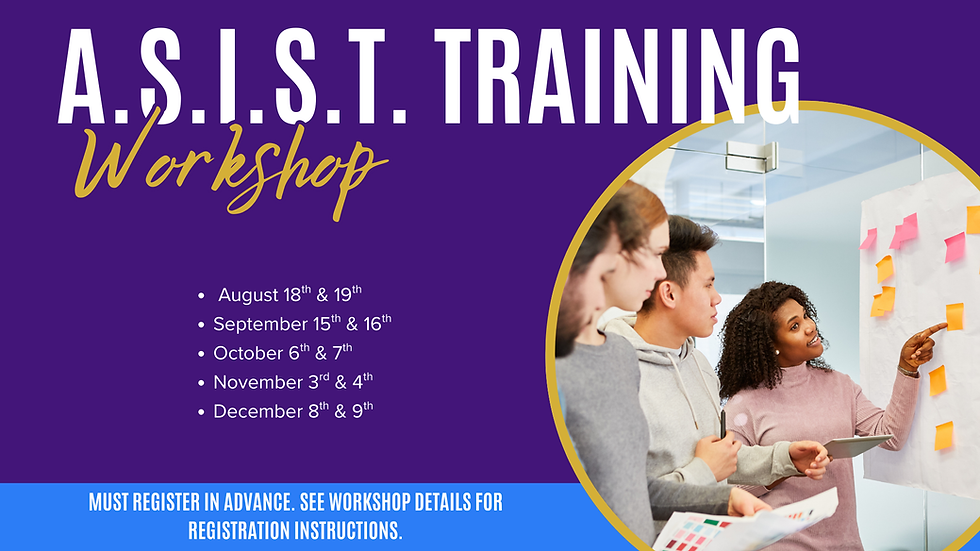The Life-Saving Power of a Safety Plan: Why It Matters When You're in Crisis
- zacharyadam9
- May 14
- 4 min read
Updated: Jun 5
Experiencing a Crisis
When you're in the middle of a mental health crisis, it can feel like the world is collapsing around you. Thoughts race, emotions surge, and it may feel impossible to think clearly or reach out for help. That’s why having a safety plan—a personalized, practical plan to support you through a crisis—can be life-saving.
What is a Safety Plan?
A safety plan is a written list of strategies and resources you can turn to when you're feeling overwhelmed, hopeless, or at risk of harming yourself. Think of it as a mental health emergency plan—a roadmap created when you're in a calm state to guide you when things feel unmanageable. Typically, a safety plan includes your personal warning signs that a crisis may be approaching, coping strategies you can use to calm yourself, names and contact information of supportive people you can reach out to, professional resources like crisis lines or mental health providers, steps to make your environment safer, and personal reasons for living that help you stay grounded.
Safety planning is important because it puts you back in control. In a crisis, it can feel like you're powerless, but a safety plan gives you something you can do. It also helps you think clearly at a time when you might not be able to rely on your memory or judgment. When your mind is in survival mode, having a written step-by-step plan makes all the difference.

Another critical benefit is that safety planning helps connect you to support. One of the most effective ways to interrupt a crisis is by reaching out, but that’s often easier said than done. A safety plan reminds you who you can call and what you can say, lowering the barrier to asking for help. Perhaps most importantly, research shows that having a safety plan reduces the risk of suicide. People who create and use safety plans as part of their mental health care are significantly less likely to make a suicide attempt. When paired with follow-up care, safety planning can play a vital role in recovery.
The best time to make a safety plan is before you’re in crisis—when you’re in a clearer, more grounded state. That said, it’s never too late to create one. You can do it on your own or with the help of a therapist, counselor, or trusted support person.
Self-Care Builds Resilience
In addition to safety planning, self-care is a powerful part of managing your mental health and preventing crises before they begin. Self-care doesn’t have to be elaborate—it’s about tuning in to your needs and making space for things that restore your energy and peace. That might mean getting enough sleep, eating regularly, taking a walk, listening to music, journaling, spending time in nature, or practicing mindfulness.

The goal is to reconnect with yourself in ways that feel nourishing and sustainable.
Making self-care a regular part of your routine can help you build emotional resilience, which makes it easier to recognize early warning signs and use your safety plan effectively. It also reminds you that your well-being matters—and that tending to your mental health is not selfish, but essential. When you care for yourself, you're better equipped to manage stress, connect with others, and move through hard moments with compassion and strength.
Resources for Safety Planning
There are many resources available to help you get started. ZeroSuicidePinellas.org/resources provides a list of local mental health resources and support. You can also call or text the 988 Suicide & Crisis Lifeline at any time for free, confidential support. The Stanley-Brown Safety Plan is a template widely used by mental health professionals. Created by Dr. Barbara Stanley and Dr. Gregory K. Brown in 2008, the Stanley-Brown safety plan is the first mental health safety plan.

Remember: Be Kind, Be Curious, Be Connected
You matter. Your story is not over. A safety plan isn’t a magic solution, but it is a powerful tool that can help you stay safe, stay connected, and take the next steps toward healing. Keep it somewhere you can easily find it, share it with someone you trust, and remember—no matter how dark things may feel, you are not alone.
Let me know if you’d like a version of this formatted for print materials, a website, or social media captions.
Sources
Bryan, C. J., Mintz, J., Clemans, T. A., Leeson, B., Burch, T. S., Williams, S. R., & Rudd, M. D. (2017). Effect of crisis response planning vs. contracts for safety on suicide risk in U.S. Army soldiers: A randomized clinical trial. Journal of Affective Disorders, 212, 64–72. https://doi.org/10.1016/j.jad.2017.01.028
Mental Health America. (2023). Taking care of yourself. Retrieved from https://www.mhanational.org/taking-care-yourself
National Institute of Mental Health. (2022). Caring for Your Mental Health. Retrieved from https://www.nimh.nih.gov/health/topics/caring-for-your-mental-health
Stanley, B., & Brown, G. K. (2012). Safety plan treatment manual to reduce suicide risk: Veteran version. U.S. Department of Veterans Affairs.
Stanley, B., Brown, G. K., Brenner, L. A., Galfalvy, H. C., Currier, G. W., Knox, K. L., Chaudhury, S. R., & Mann, J. J. (2018). Comparison of the Safety Planning Intervention with follow-up vs. usual care of suicidal patients treated in the emergency department. JAMA Psychiatry, 75(9), 894–900. https://doi.org/10.1001/jamapsychiatry.2018.1776



